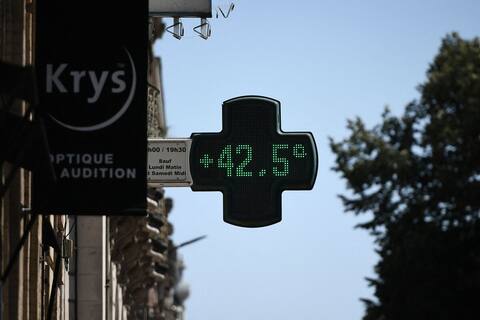LONDON | Temperature records were exceeded Monday in several French cities, under a heat wave in Western Europe which risks in particular to cross the United Kingdom on Tuesday the threshold of 40 ° C for the first time.
• Read also: European heatwave sparks wildfires
• Read also: Europe still overwhelmed by forest fires and heat wave
This is the second phenomenon of its kind in barely a month in Europe, which has led to violent fires in the Iberian Peninsula and in France.
The multiplication of heat waves is a direct consequence of global warming according to scientists, with greenhouse gas emissions increasing in intensity, duration and frequency.
In France, the map has turned crimson over a large part of the Atlantic coast, with 15 departments on red alert for a heat wave.
Records have been broken in several cities – 39.5°C in Saint-Brieuc, 42°C in Nantes or 42.6°C in Biscarosse, according to Météo France. The absolute record in the country, 46°C was reached on June 28, 2019 in Vérargues (South).
The “preventive evacuation” of 8,000 people was undertaken on Monday in two districts of La Teste-de-Buch (south-west), a town in the very touristy Arcachon basin affected by a huge fire for several days, at the edge of the Atlantic, announced the prefecture.
“I go to my daughter’s (in another district of La Teste), but if it burns there too, I don’t know what to do,” says Patricia Monteil, a forty-year-old filling her car “in panic”.
- Listen to Vincent Dessureault’s interview with Alexis Gilli, freelance journalist in Europe on QUB radio:
Referring to “non-standard” blazes, the director of the firefighters of Gironde, Marc Vermeulen, underlines that unprecedented phenomena are observed: “the fire literally explodes”, “the 40-year-old pine trunks burst”.
A man was taken into police custody on Monday as part of the investigation into the other major fire in the region, in Landiras, for which the prosecution had said it favored the “criminal thesis”.
These two disasters, which caused no casualties, ravaged more than 15,000 hectares of vegetation and forced a total of 32,000 people, residents and holidaymakers, to leave their place of residence. Five campsites from which 6,000 holidaymakers had been evacuated on Wednesday night, at the foot of the Dune du Pilat, “burnt down to 90%”, according to the authorities.
“The warming is really here”
In the UK, 38.1°C was recorded in the east of England, the highest temperature this year, the third on record.
For the first time, the British Health Security Agency has issued a level 4 alert, the highest level, corresponding to a national emergency, warning of the risks that the heat poses even to young people and / or in healthy.
“Global warming is really here. We must act in the face of this phenomenon … and also learn to live with it, ”commented Gary Evans, a 68-year-old retiree in the seaside resort of Tankerton, in the south-east of the country.
The hottest temperatures in Britain are expected for Tuesday and could exceed the 40°C threshold, a first for the country. The British record dates back to July 25, 2019, with 38.7 degrees recorded in Cambridge, in the east of England.
Some schools will remain closed, while major disruptions are expected in transport.
On Monday, Wales already exceeded its record with 37.1°C. At Kew Garens in London, 37.5°C was recorded.
Traffic at London’s Luton Airport has been suspended due to a ‘surface defect’ on the runway due to the heat.
Fires in Spain
Spain has been in the grip of a suffocating heat wave for more than a week which has caused numerous fires, ravaging tens of thousands of hectares.
On Monday, almost the entire country remained on “extreme risk” fire alert, the highest. Spain, which has been suffocating since July 10 with highs well above 40°C and falling little at night, should experience a very short respite at the start of the week.
“Climate change kills people (…), but also our ecosystem, our biodiversity”, reacted Monday the president of the government Pedro Sanchez.
Raging fires have killed a shepherd in northwestern Spain, the second fatality after a firefighter in the same area on Sunday.
After breaking its temperature record for July on Thursday, with 47°C recorded in the north of the country, Portugal should experience a much cooler day, ending a week of heat wave.
In the center and north of the country, some 800 firefighters were still fighting four fires on Monday. According to civil protection, the forest fires in 10 days left four dead, five seriously injured and led to the evacuation of 960 people.
A couple in their seventies was found dead in their charred car, the mayor of Murca (north) announced on Monday. “They were at home in the village of Penabeice and decided to flee when the flames approached their house,” added Mario Artur Lopes. Their car appears to have left the road.
Nearly 44,000 hectares have burned since the start of the year, according to the Institute for Nature and Forest Conservation, more than in 2017, when the fires killed around 100 people.
The Netherlands recorded its hottest day of the year so far on Monday, with the temperature reaching 35.4°C in the southwestern town of Westdorpe. On Tuesday, temperatures could reach 39°C in the south and center of the Netherlands.
Belgium also fears heat records on Tuesday, the thermometer can climb in places up to 40 ° C, according to the Royal Institute of Meteorology (IRM). Schedules have been arranged for certain trades exposed to heat.
About half of the territory of the EU is currently facing a risk of drought due to the prolonged lack of precipitation, which exposes countries such as France, Romania, Spain, Portugal and Italy to a probable decline in crop yields, according to the European Commission.



